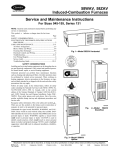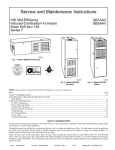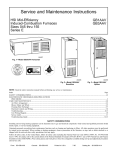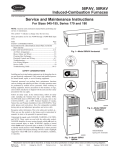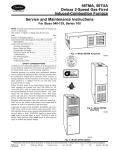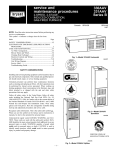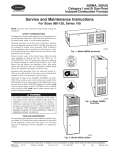Download Carrier 58RAV Instruction manual
Transcript
58PAV, 58RAV Induced-Combustion Furnaces Service and Maintenance Instructions For Sizes 045-155, Series 161 NOTE: Read the entire instruction manual before performing any service or maintenance. This symbol → indicates a change since the last issue. Index Page SAFETY CONSIDERATIONS..................................................1-2 ELECTROSTATIC DISCHARGE (ESD) PRECAUTIONS PROCEDURES.........................................................................2 CARE AND MAINTENANCE................................................2-11 Air Filter Arrangement..........................................................2-3 Blower Motor and Wheel......................................................3-4 Cleaning Heat Exchanger......................................................4-5 Electrical Controls and Wiring.................................................6 Troubleshooting ...................................................................6-11 Unit Wiring Diagram................................................................8 Service Label ............................................................................9 Troubleshooting Guide ......................................................10-11 A94087 Fig. 1—Model 58RAV Horizontal ® SAFETY CONSIDERATIONS Installing and servicing heating equipment can be hazardous due to gas and electrical components. Only trained and qualified personnel should install, repair, or service heating equipment. Untrained personnel can perform basic maintenance functions such as cleaning and replacing air filters. All other operations must be performed by trained service personnel. When working on heating equipment, observe precautions in the literature, on tags, and on labels attached to or shipped with the unit and other safety precautions that may apply. Follow all safety codes. In the United States, follow all safety codes including the National Fuel Gas Code (NFGC) NFPA No. 54-1992/ANSI Z223.1-1992. In Canada, refer to the current edition of the National Standard of Canada CAN/CGA-B149.1and .2-M95 Natural Gas and Propane Installation Codes (NSCNGPIC). Wear safety glasses and work gloves. Have fire extinguisher available during start-up and adjustment procedures and service calls. ama CANADIAN GAS ASSOCIATION A PP R O VED R Recognize safety information. This is the safety-alert symbol . When you see this symbol on the furnace and in instructions or manuals, be alert to the potential for personal injury. A94086 Fig. Understand the signal words DANGER, WARNING, and CAUTION. These words are used with the safety-alert symbol. DANGER identifies the most serious hazards which will result in severe personal injury or death. WARNING signifies a hazard which could result in personal injury or death. CAUTION is used to identify unsafe practices which would result in minor personal injury or product and property damage. NOTE is used to highlight suggestions which will result in enhanced installation, reliability, or operation. 2—Model 58RAV Downflow CERTIFICATION OF MANUFACTURING SITE A94085 Fig. 3—Model 58PAV Upflow Manufacturer reserves the right to discontinue, or change at any time, specifications or designs without notice and without incurring obligations. Book 1 4 PC 101 Catalog No. 565-977 Printed in U.S.A. Form 58P,R-13SM Pg 1 5-96 Replaces: 58P,R-12SM Tab 6a 8a The ability to properly perform maintenance on this equipment requires certain expertise, mechanical skills, tools, and equipment. If you do not possess these, do not attempt to perform any maintenance on this equipment other than those procedures recommended in the User’s Manual. FAILURE TO FOLLOW THIS WARNING COULD RESULT IN POSSIBLE DAMAGE TO THIS EQUIPMENT, SERIOUS PERSONAL INJURY, OR DEATH. Never store anything on, near, or in contact with the furnace, such as: 1. Spray or aerosol cans, rags, brooms, dust mops, vacuum cleaners, or other cleaning tools. 2. Soap powders, bleaches, waxes or other cleaning compounds, plastic or plastic containers, gasoline, kerosene, cigarette lighter fluid, dry cleaning fluids, or other volatile fluids. 3. Paint thinners and other painting compounds, paper bags, or other paper products. A failure to follow this warning could result in corrosion of the heat exchanger, fire, personal injury, or death. ELECTROSTATIC DISCHARGE (ESD) PRECAUTIONS PROCEDURE Electrostatic discharge can affect electronic components. Take precautions during furnace installation and servicing to protect the furnace electronic control. Precautions will prevent electrostatic discharges from personnel and hand tools which are held during the procedure. These precautions will help to avoid exposing the control to electrostatic discharge by putting the furnace, the control, and the person at the same electrostatic potential. Turn off the gas and electrical supplies to the unit before performing any maintenance or service. Follow the operating instructions on label attached to furnace. A failure to follow this warning could result in personal injury. The minimum maintenance that should be performed on this equipment is as follows: 1. Check and clean air filter each month or more frequently if required. Replace if torn. 2. Check blower motor and wheel for cleanliness each heating and cooling season. Clean and lubricate as necessary. 3. Check electrical connections for tightness and controls for proper operation each heating season. Service as necessary. 1. Disconnect all power to the furnace. DO NOT TOUCH THE CONTROL OR ANY WIRE CONNECTED TO THE CONTROL PRIOR TO DISCHARGING YOUR BODY’S ELECTROSTATIC CHARGE TO GROUND. 2. Firmly touch a clean, unpainted, metal surface of the furnace chassis which is close to the control. Tools held in a person’s hand during grounding will be satisfactorily discharged. 3. After touching the chassis you may proceed to service the control or connecting wires as long as you do nothing that recharges your body with static electricity (for example; DO NOT move or shuffle your feet, DO NOT touch ungrounded objects, etc.). 4. If you touch ungrounded objects (recharge your body with static electricity), firmly touch furnace again before touching control or wires. 5. Use this procedure for installed and uninstalled (ungrounded) furnaces. 6. Before removing a new control from its container, discharge your body’s electrostatic charge to ground to protect the control from damage. If the control is to be installed in a furnace, follow items 1 through 5 before bringing the control or yourself into contact with the furnace. Put all used AND new controls into containers before touching ungrounded objects. 7. An ESD service kit (available from commercial sources) may also be used to prevent ESD damage. As with any mechanical equipment, personal injury can result from sharp metal edges, etc., therefore, be careful when removing parts. AIR FILTER ARRANGEMENT The air filter arrangement may vary depending on the application. Refer to Table 1 or 2 for filter size information. Table 1—Filter Size Information for Downflow/Horizontal Furnaces (In.) FURNACE CASING WIDTH 14-3/16 17-1/2 21 24-1/2 FILTER QUANTITY AND SIZE (2) 14 X 20 X 1 (2) 14 X 20 X 1 (2) 16 X 20 X 1 (2) 16 X 20 X 1 FILTER TYPE Cleanable Cleanable Cleanable Cleanable Table 2—Filter Size Information for Upflow Furnaces (In.) CARE AND MAINTENANCE For continuing high performance and to minimize possible equipment failure, it is essential that periodic maintenance be performed on this equipment. Consult your local dealer as to the proper frequency of maintenance and the availability of a maintenance contract. FURNACE CASING WIDTH 14-3/16 17-1/2 21 24-1/2 FILTER QUANTITY AND SIZE Side Return Bottom Return (1) 16 X 25 X 1* (1) 14 X 25 X 1 (1) 16 X 25 X 1* (1) 16 X 25 X 1 (1) 16 X 25 X 1 (1) 20 X 25 X 1* (2) 16 X 25 X 1* (1) 24 X 25 X 1 FILTER TYPE Cleanable Cleanable Cleanable Cleanable * Factory-provided with the furnace. Filters may be field modified as required by cutting to desired size. 2 d. Furnaces are equipped with permanent, washable filters. Clean filters with tap water. Spray water through filter in opposite direction of airflow. e. Rinse and let dry. Oiling or coating of filters is not recommended or required. f. Reinstall filters. g. Replace blower access door. AIRFLOW h. Restore electrical power to furnace. 2. Upflow Each furnace requires 1 or 2 filters which are installed in the blower compartment. (See Fig. 6.) To remove filters for cleaning or replacement, proceed as follows: A94307 a. Disconnect electrical power before removing access doors. Fig. 4—Horizontal Filter Arrangement b. Remove blower and control access doors. c. Release filter retainer from clip at front of furnace casing. (See Fig. 6.) For side return, clips may be used on either or both sides of the furnace. AIRFLOW INSTALLATION POSITION OF FILTERS d. Slide filter(s) out. e. Furnaces are equipped with permanent, washable filters. Clean filters with tap water. Spray water through filter in opposite direction of airflow. RETURN-AIR PLENUM f. Rinse and let dry. Oiling or coating of filter is not recommended or required. g. Reinstall filter(s). h. Replace blower and control access doors. i. Restore electrical power to furnace. BLOWER MOTOR AND WHEEL For long life, economy, and high efficiency, clean accumulated dirt and grease from the blower wheel and motor annually. The following steps should be performed by a qualified service technician. Some motors have prelubricated sealed bearings and require no lubrication. These motors can be identified by the absence of oil ports on each end of the motor. For those motors with oil ports, lubricate motor every 5 years if motor is used on intermittent operation (thermostat FAN in AUTO mode), or every 2 years if motor is in continuous operation (thermostat FAN in ON mode). ACCESS DOOR NOTE: Remember to disconnect the electrical supply before removing access doors. Clean and lubricate as follows: A88486 Fig. 5—Downflow Filter Arrangement 1. Remove screw from blower access door (downflow/horizontal furnace only) and remove blower access door. 2. Remove vent pipe enclosure (downflow/horizontal furnace only) and disconnect short piece of vent pipe from relief box. Never operate unit without a filter or with filter access door removed. A failure to follow this warning could result in fire, personal injury, or death. 3. Disconnect wires from auxiliary limit on blower housing (when used on downflow/horizontal furnace only). 4. Remove control. 1. Downflow/Horizontal 5. Disconnect electrical leads from control. (See Fig. 6 or 7.) Note location of wires for reassembly. Each furnace requires 2 filters which are installed in the return-air duct. (See Fig. 4 and 5.) To remove filters for cleaning or replacement, proceed as follows: 6. Remove screws holding blower assembly to blower deck and slide blower assembly out of furnace. a. Disconnect electrical power before removing blower access door. 7. Loosen screw in strap holding motor capacitor to blower housing and slide capacitor out from under strap. b. Remove screw from front of door and remove blower access door. 8. Mark blower wheel, motor, and motor support in relation to blower housing before disassembly to ensure proper reassembly. c. Reach up behind top plate, tilt filters toward center of return-air plenum, remove filters, and clean as needed. Replace if torn. 9. Loosen setscrew holding blower wheel on motor shaft. 3 VENT PIPE ENCLOSURE DRAFT SAFEGUARD SWITCH RELIEF BOX AUXILIARY LIMIT SWITCH (WHEN USED) 24V MOUNTING SCREWS COM W FLUE COLLECTOR BOX HUM MOUNTING SCREWS CONTROL BOARD Y R G CONTROL BOARD RELIEF BOX FILTER RETAINER DRAFT SAFEGUARD SWITCH HUM 24V COM W Y R G WASHABLE FILTER MANUAL RESET LIMIT SWITCHES A92063 A92064 Fig. 6—Model 58PAV Upflow Fig. 7—Model 58RAV Downflow 10. Remove bolts holding motor mount to blower housing and slide motor and mount out of housing. Disconnect ground wire attached to blower housing before removing motor. 18. Reconnect wires to auxiliary limit switch on blower housing (downflow/horizontal furnace only). 19. Reinstall vent pipe and enclosure (downflow/horizontal furnace only). 11. Lubricate motor (when oil ports are provided). a. Remove dust caps or plugs from oil ports located at each end of motor. 20. Turn on electrical power and check for proper rotation and speed changes between heating and cooling. b. Use a good grade of SAE 20 nondetergent motor oil and put 1 teaspoon, 5 cc, 3/16 oz, or 16 to 25 drops in each oil port. Do not over-oil. 21. Replace blower access door. Secure (downflow/horizontal furnace only). c. Allow time for total quantity of oil to be absorbed by each bearing. The following steps should be performed by a qualified service technician. d. Wipe excess oil from motor housing. NOTE: Deposits of soot and carbon indicate the existence of a problem which needs to be corrected. Take action to correct the problem. with screw CLEANING HEAT EXCHANGER e. Replace dust caps or plugs on oil ports. 12. Remove blower wheel from housing. If it becomes necessary to clean the heat exchanger because of carbon deposits, soot, etc., proceed as follows: a. Mark cutoff location to ensure proper reassembly. b. Remove screws holding cutoff plate and remove cutoff plate from housing. 1. Turn off gas and electrical power to furnace. 2. Remove screw from front of blower access door (downflow/horizontal furnace only) and remove control and blower access doors. c. Lift blower wheel from housing through opening. 13. Clean blower wheel and motor using a vacuum cleaner with soft brush attachment. Do not remove or disturb balance weights (clips) on blower wheel blades. The blower wheel should not be dropped or bent as balance will be affected. 3. Remove vent pipe enclosure (downflow/horizontal furnace only) and disconnect vent pipe from relief box. 4. Remove 2 screws that secure relief box. (See Fig. 6 or 7.) 14. Reinstall blower wheel by reversing items 12 a through c. Be sure wheel is positioned for proper rotation. 5. Disconnect wires to the following components. a. Draft safeguard switch 15. Reassemble motor and blower by reversing items 5 through 10. If motor has ground wire, be sure it is connected as before. b. Inducer motor c. Pressure switch d. Limit overtemperature switch(es) e. Gas valve Be sure the motor is properly positioned in the blower housing. The motor oil ports must be at a minimum of 45° above the horizontal centerline of the motor after the blower assembly has been reinstalled in the furnace. f. Hot surface ignitor g. Flame-sensing electrode 6. Remove 8 screws that secure flue collector box to center panel. Be careful not to damage sealant. 16. Reinstall blower assembly in furnace. 7. Remove complete inducer assembly from furnace, exposing flue openings. 17. Reinstall control. Connect blower electrical leads to control. Please note that the common wire connection is 3/16 in. and all other wire connections are 1/4 in. for assembly. DO NOT FORCE. 8. Clean cells using field-provided small wire brush, steel spring cable, reversible electric drill, and vacuum cleaner. 4 a. Assemble wire brush and steel spring cable. (3.) Work cable in and out of cell 3 or 4 times to obtain sufficient cleaning. DO NOT pull cable with great force. Reverse drill and gradually work cable out. (4.) Remove burner assembly and cell inlet plates. (1.) Use 48 in. of 1/4-in. diameter high-grade steel spring cable (commonly known as drain clean-out or RotoRooter cable). (2.) Use 1/4-in. diameter wire brush (commonly known as 25-caliber rifle cleaning brush). Be very careful when removing the burner assembly to avoid breaking the ignitor. See Fig. 9 for the correct ignitor location. NOTE: The materials needed in items (1.) and (2.) can usually be purchased at local hardware stores. (3.) Insert twisted wire end of brush into end of steel spring cable, and crimp tight with crimping tool or strike with ball-peen hammer. TIGHTNESS is very important. (4.) Remove metal screw fitting from wire brush to allow insertion into cable. b. Clean each heat exchanger cell. (1.) Attach variable-speed, reversible drill to end of steel spring cable (end opposite brush). (2.) Insert brush end of cable into upper opening of cell and slowly rotate with drill. DO NOT force cable. Gradually insert at least 36 in. of cable into 2 upper passes of cell. (See Fig. 8.) 9. 10. 11. 12. A91252 Fig. 8—Cleaning Heat Exchanger Cell 11 32" 13 32" 13. BURNER 14. 15. 16. CELL PANEL (5.) Replace screws in center panel and cells before cleaning. (6.) Insert brush end of cable in lower opening of cell, and proceed to clean 2 lower passes of cell in same manner as 2 upper passes. (7.) Repeat foregoing procedures until each cell in furnace has been cleaned. (8.) Remove residue from each cell using vacuum cleaner. (9.) Clean burner assembly using vacuum cleaner with soft brush attachment. (10.) Reinstall cell inlet plates and burner assembly. Care must be exercised to center the burners in the cell openings. After cleaning flue openings, check sealant on flue collector to ensure that it has not been damaged. If new sealant is needed, contact your dealer or distributor. Clean and replace flue collector assembly, making sure all 8 screws are secure. Reinstall relief box. Reconnect wires to the following components. a. Draft safeguard switch b. Inducer motor c. Pressure switch d. Limit overtemperature switch(es) e. Gas valve f. Hot surface ignitor g. Flame-sensing electrode Reconnect vent pipe to relief box. Replace vent pipe enclosure (when used on downflow/horizontal furnace only). Replace blower access door only. Turn on electrical power and gas. Set thermostat and check furnace for proper operation. Never use a match or other open flame to check for gas leaks. Use a soap-and-water solution. A failure to follow this warning could result in fire, personal injury, or death. HOT SURFACE IGNITOR ASSEMBLY 17. Check for gas leaks. 18. Replace control access door on upflow furnace. 19. On downflow/horizontal furnaces, remove blower access door, replace control access door first, then replace blower access door and secure with screw in front of door. C L 7 8" IGNITOR C L BURNER IGNITOR ASSEMBLY A93347 Fig. 9—Position of Ignitor to Burner 5 → ELECTRICAL CONTROLS AND WIRING b. Inducer motor starts and continues to run the entire component test. c. Hot surface ignitor is energized for 15 sec, then deenergized. There may be more than 1 electrical supply to the unit. Check accessories and cooling unit for additional electrical supplies. d. Main blower operates at cooling speed for 10 sec, then turns off. The electrical ground and polarity for 115-v wiring must be maintained properly. Refer to Fig. 10 for field wiring information and to Fig. 12 for unit wiring information. e. Main blower operates at heating speed for 10 sec, then turns off. → NOTE: If the polarity is not correct, the STATUS LED on the control center will flash rapidly and prevent the furnace from operating. The control system also requires an earth ground for proper operation of the control board and flame-sensing electrode. f. Inducer motor stops. Items a through e above will assist in furnace troubleshooting since all components are functionally operated except the gas valve. This procedure is also referred to as "Component Test." The 24-v circuit contains an automotive-type, 3-amp fuse located on the control board. (See Fig. 11.) Any direct shorts of the 24-v wiring during installation, service, or maintenance will cause this fuse to blow. If fuse replacement is required, use ONLY a fuse of identical size. 3. Operate furnace through 1 heat cycle to test for proper operation and check LED status. 4. If furnace is operating properly and LED indicates proper operation, replace control access door. 5. Component Test can also be initiated by performing the following: With power to the unit disconnected, check all electrical connections for tightness. Tighten all screws on electrical connections. If any smoky or burned connections are found, disassemble the connection, clean all parts, strip wire, and reassemble properly and securely. a. Remove control access door. b. Remove blower access door. c. Manually close blower access door switch. Reconnect electrical power to the unit and observe unit through 1 complete operating cycle. Electrical controls are difficult to check without proper instrumentation; if there are any discrepancies in the operating cycle, contact your dealer and request service. Blower access door switch opens 115-v power to control center. No component operation can occur. Caution must be taken when manually closing this switch for service purposes. Failure to follow this warning could result in personal injury or death. For an explanation of fault codes, refer to service label located on blower access door or Fig. 13, and the troubleshooting guide. The control center stores 1 fault code (the last fault to occur) for a period of 48 hrs or until the 115- or 24-v power is interrupted. NOTE: Removing blower access door will open blower access door switch and terminate 115-v power to control center, and fault code will be erased. Look into blower access door sight glass for current LED status. d. BRIEFLY short (jumper) TEST, 1/4-in. quick-connect terminal on control center (adjacent to LED diagnostic light) and Com terminal on thermostat connection block. (See Fig. 11.) 1. To retrieve fault code, proceed with the following: NOTE: If TEST to Com terminals are jumpered longer than 2 sec, LED will flash rapidly, and retrieval request will be ignored. NOTE: NO thermostat signal may be present at control center, and all blower time delay off periods must be completed. a. Leave 115-v power to furnace turned on. e. Component Test will function as described in item 2 above. b. Look into blower access door sight glass for current LED status. f. Check LED status. g. If LED status indicates proper operation, release blower access door switch, replace blower access door, and replace control access door. NOTE: Leave blower access panel installed to maintain power to control center to view current LED status. c. Remove control access door. TROUBLESHOOTING d. BRIEFLY remove either wire from the main limit switch until LED goes out, then reconnect it. Refer to the service label. (See Fig. 13.) Pages 10 and 11 contain a troubleshooting guide. This guide can be a useful tool in isolating furnace operation problems. Beginning with the word "Start," answer each question and follow the appropriate arrow to the next item. NOTE: If wire to main limit is disconnected longer than 4 sec, main blower starts, and retrieval request is ignored. 2. When above items have been completed, the following will occur: The guide will help to identify the problem or failed component. After replacing any component, verify correct operation sequence. a. LED flashes a fault code 4 times. Record this fault code for further troubleshooting. 6 FIELD 24-VOLT WIRING FIELD 115-, 208/230-, 460-VOLT WIRING FACTORY 24-VOLT WIRING FACTORY 115-VOLT WIRING NOTE 2 W FIVE WIRE C R G Y THERMOSTAT TERMINALS FIELD-SUPPLIED FUSED DISCONNECT THREE-WIRE HEATINGONLY BLK BLK W WHT WHT R GND G 115-VOLT FIELD- AUXILIARY J-BOX SUPPLIED CONTROL FUSED BOX DISCONNECT C GND NOTE 1 Y 24-VOLT TERMINAL BLOCK FURNACE 208/230VOLT SINGLE PHASE CONDENSING UNIT TWO WIRE NOTES: 1. Connect Y-terminal as shown for proper operation. 2. Some thermostats require a "C" terminal connection as shown. 3. If any of the original wire, as supplied, must be replaced, use same type or equivalent wire. AA95241 Fig. 10—Heating and Cooling Application Wiring Diagram 24V TEST/TWIN COM W Y R G GND 208/230- OR 460-VOLT THREE PHASE HUM 24-V THERMOSTAT TERMINALS HUMIDIFIER TERMINAL (24-VAC 0.5 AMP MAX) LED OPERATION & DIAGNOSTIC LIGHT HARNESS CONNECTOR SEC-1 24-V TRANSFORMER SEC-2 3-AMP FUSE SPARE-1 COOL HEAT BLOWER SPEED SELECTION TERMINALS SPARE-2 EAC-1 EAC-ELECTRONIC AIR CLEANER TERMINALS (115-VAC 1.5 AMP MAX) 115-VAC (L1) POWER SUPPLY HOT SURFACE IGNITOR CONNECTOR EAC-2 115-VAC (L2) NEUTRAL CONNECTION INDUCER MOTOR CONNECTOR A95086 Fig. 11—Control Board 7 8 GV GVR HI/LO HSI HSIR HUM IDM IDR ILK JB LED LGPS LS OL ALS BLWR BLWM CAP CPU DSS EAC-1 EAC-2 FL FRS FSE FU1 FU2 HSI 2 PL5 1 2 PL3 1 2 3 L2 BLK WHT C OM PR2 EAC-2 IDM HEAT SPARE-2 EAC-1 COOL SPARE-1 24 VAC-3A FUSE RED DSS WHT (COM) RED (LO) BLU (MED LO) NOTE #8 ILK OL PRS JB BRN GRN WHT BLK FU2 Fig. 12—Wiring Diagram PLUG RECEPTACLE FIELD SPLICE EQUIPMENT GROUND FIELD GROUND FIELD WIRING TERMINAL CONDUCTOR ON PCB FIELD WIRING (24VAC) FIELD WIRING (115VAC) FACTORY WIRING (24VAC) FACTORY WIRING (115VAC) PCB TERMINAL UNMARKED TERMINAL JUNCTION NEUTRAL L1 FUSED DISCONNECT SWITCH (WHEN REQ’D) NOTE #4 CAP NOTE #5 2-C GV 3-P PRINTED CIRCUIT BOARD 9-CIRCUIT CONNECTOR 2-CIRCUIT PCB CONNECTOR 3-CIRCUIT IDM CONNECTOR 2-CIRCUIT HSI/PCB CONNECTOR PRESSURE SWITCH, SPST-(N.O.) COMPONENT TEST & TWIN TERMINAL TRANSFORMER-115VAC/24VAC GRN BLWM START GRN WHT (COM) GRN WHT BLK FL 1-M BLU YEL FRS2 BRN (WHEN USED) BLK RED BLU LS PCB PL1 PL2 PL3 PL5 PRS TEST/TWIN TRAN WHT FSE FRS1 (WHEN USED) NOTE #12 ALS YEL (MED HI) BLK (HI) RED WHT ORN AUXILIARY LIMIT SWITCH, OVERTEMP. -MANUAL RESET, SPST-(N.C.) BLOWER MOTOR RELAY, SPST-(N.O.) BLOWER MOTOR CAPACITOR MICROPROCESSOR AND CIRCUITRY DRAFT SAFEGUARD SWITCH ELECTRONIC AIR CLEANER CONNECTION (115 VAC 1.5 AMP MAX.) ELECTRONIC AIR CLEANER CONNECTION (COMMON) FUSIBLE LINK FLAME ROLLOUT SW. -MANUAL RESET, SPST-(N.C.) FLAME PROVING ELECTRODE FUSE, 3 AMP, AUTOMOTIVE BLADE TYPE, FACTORY INSTALLED FUSE OR CIRCUIT BREAKER CURRENT INTERRUPT DEVICE (FIELD INSTALLED & SUPPLIED) GAS VALVE-REDUNDANT OPERATORS GAS VALVE RELAY, DPST-(N.O.) BLOWER MOTOR SPEED CHANGE RELAY, SPDT HOT SURFACE IGNITOR (115 VAC) HOT SURFACE IGNITOR RELAY, SPST-(N.O.) 24VAC HUMIDIFIER CONNECTION (.5 AMP. MAX.) INDUCED DRAFT MOTOR INDUCED DRAFT RELAY, SPST-(N.O.) BLOWER ACCESS PANEL INTERLOCK SWITCH, SPST-(N.O.) JUNCTION BOX LIGHT-EMITTING DIODE FOR STATUS CODES LOW GAS PRESSURE SWITCH, SPST-(N.O.) LIMIT SWITCH, AUTO RESET, SPST(N.C.) AUTO-RESET INTERNAL MOTOR OVERLOAD TEMP. SW. LEGEND 1 PL2 BLOWER SPEED SELECT FU1 LED SEC-2 6 5 4 9 8 7 3 2 1 SEC-1 PL1 TEST/TWIN HI/LO RELAY BLWR GVR 225 SEC 180 SEC 135 SEC IDR BLK 120 VAC L1 PR1 HSIR BLK 90 SEC BLOWER OFF DELAY SELECTION CHART NOTE #9 (NOT ON ALL MODELS) BLK G R Y W C OM HUM 1.5 AMP PCB WHT SW2 BLOWER OFF DELAY SW1 WHT TRAN L1 FU1 IDR HSIR HSIR HI/LO IDR CPU BLWR GVR-2 SEC-1 TRAN PR1 EAC-2 EAC-1 NOTE #6 BLWR 2 1 HI/LO PR2 PL5 GVR-1 GVR SEC-2 24VAC 115VAC PL2 2 1 1 9 6 5 8 2 3 4 1 7 2 3 HSI OL 1-M 3-P DSS NOT USED NOT USED PL1 PRS FRS2 IDM CAP FSE NOTE #5 2-C L2 FL ALS (WHEN USED) NOTE #11 GV LS BLWM START (WHEN USED FRS1 NOT USED PL3 LO MED LO MED HI HI SPARE-1 NOTE #8 COOL COM COM SPARE-2 HEAT EQUIPMENT GROUND SCHEMATIC DIAGRAM TO 115VAC FIELD DISCONNECT (NATURAL GAS & PROPANE) NOTE #4 NEUTRAL A95335 1. If any of the original equipment wire is replaced use wire rated for 105°C. 2. Inducer (IDM) and blower (BLWM) motors contain internal auto-reset thermal overload switches (OL). 3. Blower motor speed selections are for average conditions, see installation instructions for details on optimum speed selection. 4. Use only copper wire between the disconnect switch and the furnace junction box (JB). 5. This wire must be connected to furnace sheetmetal for control to detect flame. 6. Replace only with a 3 amp fuse. 7. Yellow lead not on all motors. 8. Blower-on delay, gas heating 45 seconds, cooling or heat pump 2 seconds. 9. Blower-off delay, gas heating 90, 135, 180 or 225 seconds, cooling or heat pump 90 seconds. (135 seconds only on some models) 10. Ignition-lockout will occur after four consecutive unsuccessful trials-for-ignition. Control will auto-reset after three hours. 11. When used auxiliary limit switch (ALS) is on downflow models only. When used FL is on upflow models only. 12. Some models may have spade quick connect terminals. 322869-101 REV. C NOTES: COM G Y W R NOTE #12 HUM TEST/TWIN ILK L1 SERVICE LED CODE CONTINUOUS OFF CONTINUOUS ON RAPID FLASHING - STATUS Check for 115VAC at L1 and L2, and 24VAC at SEC-1 and SEC-2. Control has 24V power. Line voltage (115V) polarity reversed. If twinned, refer to twinning kit instructions. EACH OF THE FOLLOWING STATUS CODES IS A TWO DIGIT NUMBER WITH THE FIRST DIGIT DETERMINED BY THE NUMBER OF SHORT FLASHES AND THE SECOND DIGIT BY THE NUMBER OF LONG FLASHES. 11 NO PREVIOUS CODE - Stored status codes are erased when power (115V or 24V) to control is interrupted or 48 hours after each fault is cleared. 12 BLOWER ON AFTER POWER UP (115V or 24V) - Blower runs for 90 seconds, if unit is powered up during a call for heat (R-W closed). 13 LIMIT OR FLAME ROLL-OUT SWITCH LOCKOUT - Auto reset after three hours. For flame roll-out switch or fuse link, refer to #33. 14 IGNITION LOCKOUT - Control will auto-reset after three hours. Refer to #34. 21 GAS HEATING LOCKOUT - Control will NOT auto reset. Check for: - Stuck gas valve relay on control or miswire to gas valve circuit. 22 ABNORMAL FLAME-PROVING SIGNAL - Flame is proved while gas valve is de-energized. Inducer will run until fault is cleared. Check for: - Stuck-open gas valve or leaky gas valve. 23 PRESSURE SWITCH DID NOT OPEN Check for: - Obstructed pressure tubing. - Defective pressure switch (stuck closed). 24 SECONDARY VOLTAGE FUSE IS OPEN Check for: - Short circuit in secondary voltage (24V) wiring. 31 PRESSURE, DRAFT SAFEGUARD, OR AUXILIARY-LIMIT (when used) SWITCH DID NOT CLOSE OR REOPENED - If open longer than five minutes, inducer shuts off for 15 minutes before retry. Check for: - Proper vent sizing and condensate pitch. - Inadequate Combustion air supply. - Vent restriction or high winds. - Low inducer voltage. - Defective inducer motor or start capacitor. - Disconnected or obstructed pressure tubing. - Defective pressure switch or connections. If it opens after trial for ignition period, blower will come on for 90 second recycle delay. 33 LIMIT OR FLAME ROLL-OUT SWITCH IS OPEN - If open longer than three minutes,code changes to #13. Check for: - Defective blower motor or start capacitor. - Dirty filter or restricted duct system. - Loose blower wheel. - Defective switch or connections. - Inadequate Combustion air supply Flame Roll-out Switch or fuse link. - Open Flame Roll-out switch,or fuse link. Manual reset or replace. 34 IGNITION PROVING FAILURE - Control will try three more times before a lockout #14 occurs. If flame signal lost after trial for ignition period, blower will come on for 90 second recycle delay. Check for: - Oxide buildup on flame sensor (clean with fine sandpaper). - Proper flame sense microamps (.5 microamps D.C. minimum). - Gas valve turned off. - Manual shut-off valve. - Low inlet gas pressure. - Green wire MUST be connected to furnace sheet metal. - Inadequate flame carryover or rough ignition. COMPONENT TEST To initiate the component test sequence,shut OFF the room thermostat or disconnect the "R" thermostat lead. Briefly short the TEST terminal to the ’C’ terminal. Status LED will flash code and then turn ON the inducer motor. The inducer motor will run for the entire component test. The hot surface ignitor, blower motor-heat speed, and blower motorcool speed will be turned ON for 10-15 seconds each. 3 9 6 TEST 4 1 7 STATUS 2 5 8 → C HUM W Y R G 320615-102 REV. F A96213 Fig. 13—Service Label 9 10 START Go to section with status code determined. Determine status code. The status code is a 2 digit number with the first digit determined by the number of short flashes and the second digit by the number of long flashes. Once status code is determined, the control will go through a brief component test sequence. The inducer will start and run for the entire component test. The HSI, blower motor heat speed, and blower motor cool speed will run for 10-15 sec each. YES Is red LED status light blinking ON/OFF slowly with a combination of short and long flashes? NO Is red LED status light blinking rapidly without a pause? YES Is red LED status light on? NO YES NO YES Was there a previous fault code other than No. 11? Check for previous fault by momentarily shorting the TEST terminal and the C terminal until the LED goes out. LED will flash the status code of any previous fault or the code No. 11 (1 short and 1 long flash) if no previous fault. After the control repeats the code 3 times, the control will go through a brief component test sequence. The inducer will start and run for the entire component test. The HSI, blower motor heat speed, and blower motor cool speed will run for 10-15 sec each. Check for correct line voltage polarity. If units are twinned, check for proper low-voltage (24v) transformer phasing. Replace control center. YES Is there 24v at SEC-1 and SEC-2? YES Is there 115v at L1 and L2? NO NO NO Run system through a heating or cooling cycle to check operation. Status codes are erased after 48 hrs or whenever power (115v or 24v) is interrupted. YES Does control respond to W, Y, or G 24-vac thermostat signals? Replace transformer. Replace door switch. YES Is there 115v going to switch? YES Is door switch closed? TROUBLESHOOTING GUIDE NO NO NO Replace control if it does not respond to 24-vac signal at W, Y, or G screw terminals. YES Is 24 vac present at W, Y, or G terminals on the control? NO Check room thermostat or interconnecting cable. NO Close circuit breaker and go back to start. Check for continuity in wire from circuit breaker to furnace. YES Is circuit breaker closed? Close door switch and go to start. 11 24 LOW-VOLTAGE FUSE IS OPEN - Check for: • Short in low-voltage wiring including thermostat leads shorting to ductwork or furnace cabinet. Disconnect thermostat leads to isolate short circuit. 23 PRESSURE SWITCH WILL NOT OPEN - Check for: • Disconnected or obstructed pressure tubing. • Defective pressure switch. 22 ABNORMAL FLAME PROVING SIGNAL - Flame was sensed while gas valve was de-energized. Inducer will run until fault is cleared. Check for: • Stuck open gas valve solenoid or leak. • Defective control board. 21 GAS HEATING LOCKOUT Turn off power and wait 5 minutes to retry. Check for: • Stuck closed gas valve relay on control. • Miswire or short to gas valve wire. 14 IGNITION LOCKOUT - System failed to ignite gas and prove flame in 4 attempts. Control will auto-reset in 3 hrs. See No. 34 13 LIMIT OR FLAME ROLLOUT SWITCH LOCKOUT - Limit switch was open longer than 3 minutes. Auto-reset will occur after 3 hrs. Flame rollout switch requires manual reset. See No. 33 12 BLOWER ON AFTER POWER UP (115V OR 24V) - Normal operation. Blower will run for 90 sec when furnace power is interrupted during a call for heat and R-W closes. 11 NO PREVIOUS FAULT - Faults are erased after 48 hrs or whenever power (115V or 24V) is interrupted. Run system through a heating or cooling cycle to recheck system. YES 34 IGNITION PROVING FAILURE If flame is not sensed during the trial for ignition period, the control will repeat the ignition sequence 3 more times before going into lockout, No. 14. If flame signal is lost after trial for ignition period, blower will come on for 90 sec recycle delay. Check for the following items first before proceding to the next step. • Gas valve turned off. • Manual shut-off valve. • Green wire must be connected NO to furnace sheet metal. To determine whether the problem is in the gas valve, igniter, or flame sensor, the system can be operated in the component test mode to check out the ignitor. First, remove the R thermostat connection from the control board and initiate the component test sequence. Does the ignitor glow orange/white hot by the end of the 17 sec warm-up period? 33 LIMIT OR FLAME ROLLOUT SWITCH IS OPEN - If limit switch is open longer than 3 minutes, code changes to No. 13. Check for: • Blower motor failure. • Motor start capacitor. • Open flame rollout switch, manual reset. • Inadequate combustion air supply (flame rollout switch only). • Dirty filter. • Defective limit switch or connections. • Loose blower wheel. 31 PRESSURE, DRAFT SAFEGUARD (WHEN USED), OR AUXILIARY LIMIT (WHEN USED) SWITCH WILL NOT CLOSE OR REOPEN - If open longer than 5 minutes, inducer shuts off for 15 minutes before retry. Check for: • Proper vent sizing or pitch or sag. • Vent restrictions or high winds. • Defective inducer motor. • Low-line voltage (115v). • Motor start capacitor. • Low inlet gas pressure. • Defective pressure switch or connections. If it opens after trial for igniton period, blower will come on for 90 sec recycle delay. • Inadequate combustion air (for draft safeguard and auxiliary limit switches only). Allow blower to come on and repeat test to check for intermittent operation. YES Do main burners stay on? YES Do main burners ignite? YES Does gas valve open and allow gas to flow? YES Reconnect the R thermostat lead and set thermostat to call for heat. Connect voltmeter across gas valve connections. Does gas valve receive 24v? Check for continuity in the harness and ignitor. Replace defective component. YES Unplug ignitor harness from control center and inititate another component test sequence and check for 115v between pins 1 and 2 on the board. Was there 115v present for the 17 sec period? NO NO NO NO NO Fixed. NO Replace control board. Will main burner ignite and stay on? YES NO Replace electrode. Is current near typical value? YES NO Check connections and retry. If current is near typical value and control will not stay on, replace control board. Clean flame sensor with fine sandpaper and recheck current. Current is nominally 4.0 to 6.0 microamps. YES Repeat call for heat and check flame sensor current during trial for ignition period. Is the dc microamperes below 0.5? Check for: • Inadequate flame carryover on rough ignition. • Low inlet gas pressure. Check that all gas valves are turned on. Replace valve. Check connections. If OK, replace control board. Replace control board. SERVICE TRAINING Packaged Service Training programs are an excellent way to increase your knowledge of the equipment discussed in this manual, including: • Unit Familiarization • Maintenance • Installation Overview • Operating Sequence A large selection of product, theory, and skills programs is available, using popular video-based formats and materials. All include video and/or slides, plus companion book. Classroom Service Training plus "hands-on" the products in our labs can mean increased confidence that really pays dividends in faster troubleshooting, fewer callbacks. Course descriptions and schedules are in our catalog. CALL FOR FREE CATALOG 1-800-962-9212 [ ] Packaged Service Training [ ] Classroom Service Training A94328 Copyright 1996 CARRIER Corp. • 7310 W. Morris St. • Indianapolis, IN 46231 58pr13sm Manufacturer reserves the right to discontinue, or change at any time, specifications or designs without notice and without incurring obligations. Book 1 4 PC 101 Catalog No. 565-977 Printed in U.S.A. Form 58P,R-13SM Pg 12 5-96 Replaces: 58P,R-12SM Tab 6a 8a












